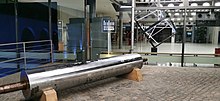Gravure cylinder

With gravure cylinder is printing form for gravure referred. In general, the printing form consists of a cylindrical hollow steel core that is covered with a copper-coated surface. The printed image in the form of tiny cells is chemically etched or electronically engraved into this approximately 100 μm thin copper layer . Finally, the copper layer is also chrome-plated in order to achieve better durability for longer runs .
Cylinder manufacture
The basic cylinder usually consists of a hollow steel core that is first coated with copper in an electrolytic bath and then with chrome after the image data have been applied. This process is carried out by electroplating the gravure cylinder. The galvanic production line usually consists of the degreasing bath, the copper bath, the chromium bath, the nickel bath and the chromium plating bath. By connecting a central chemical unit to the electroplating plant, the baths can be automatically filled with the appropriate substances. The quality of the applied copper significantly influences the quality of the subsequent engraving.
After the printing has ended, the chrome and copper layers are mechanically removed or peeled off. The cylinder surface is cleaned and polished for reuse. Then another electroplating takes place and the cylinder can be provided with an engraving again.
Basically, a gravure cylinder consists of one piece after all operations. However, there are also technologies that allow the cylinder to be built up in layers. With so-called "sleeves" B. can consist of aluminum, a carrier core is coated. This system has advantages in both economic and ecological terms, since it can be changed more quickly and less material is used. Only the sleeve is changed, the cylinder cores can still be used.
A similar method is the Ballard skin . A thin copper layer is applied in the electroplating bath, which, due to a previous treatment of the base cylinder with separating agents, does not bond firmly to it, but can be pulled off again. The Ballard skin can be processed like a normal gravure cylinder and then go to print. It also simplifies the reuse of the basic cylinder.
Transfer of the print image
The transfer of the print image to the gravure cylinder is generally referred to as engraving. The print image, ie photos, texts, graphics, bar codes, security features, etc., is etched or engraved in the form of cells in the printing cylinder.
With electromechanical engraving (EMG or E-engraving), the scanning cylinder and the printing forme cylinder to be engraved are connected to one another with a shaft. On the scanning cylinder there is a so-called opal film with all image information, texts and line drawings. A special diamond stylus is used for this, which vibrates at up to 12,000 "stitches" per second and engraves the cells in the copper surface. The diamond stylus is attached to an engraving head, which is the heart of the engraving machine ( Helio-Klischograph ) and is controlled by the engraving machine via an amplifier.
The electronic laser engraving reaches higher frequencies engraving, but the cups are not always formed with a "shot". In this respect, the engraving frequency can only be compared to a very limited extent with the frequency of an EMG system. Depending on the process, a zinc surface is used instead of copper or a thicker chrome layer, which changes the galvanic process. Basically, with laser engraving, depressions are “burned” into the cylinder surface, which have a correspondingly larger or smaller volume depending on the strength of the electronic signal. The high writing resolution of up to 2,540 dpi enables very high contour definition. That is why direct laser engraving is predestined for applications in the fields of labels, security technology and high-quality packaging, such as cigarette packaging.
In the modern etching process , the cylinder is first coated with a lacquer or photo-resistant layer, which is then exposed with a laser . This removes the layer in the places where the cells should appear later. The subsequent computer-monitored etching or electrolytic copper removal generates the final cells. In contrast to electromechanical engraving and the electronic laser method, etching is only reproducible to a limited extent and is therefore disappearing more and more from modern work processes.
application
Today, only gravure cylinders are used for typical illustration gravure, which were produced using the engraving method. The printing cylinders for almost all major magazines and for many catalogs, including the around 160 million Ikea catalogs worldwide, are produced in this way. Up to 16 engraving heads are in operation simultaneously on one engraving machine. Each engraving head covers the width of a side on the cylinder to save engraving time.
Another important area of application is packaging engraving for folding boxes, bag packaging, labels, etc. Here, a maximum of two engraving heads are used on an engraving machine. The packaging layout is arranged several times on a so-called "full sheet" and this sheet is then reproduced on the gravure cylinder. Raster marks and cut marks determine the areas in which the printed packaging is later cut or punched from the sheet. Finally, in the area of decorative papers (furniture coatings, floor coverings, wallpapers, etc.) and transfer printing (decorative fabrics), electromechanical engraving on gravure cylinders is mainly used.
literature
- Helmut Kipphan: Handbook of the print media . Springer, Heidelberg 2000, ISBN 3-540-66941-8 .
- Bernd Ollech: Gravure, basics and process steps of modern gravure technology . Polygraph, Bielefeld 1999.


